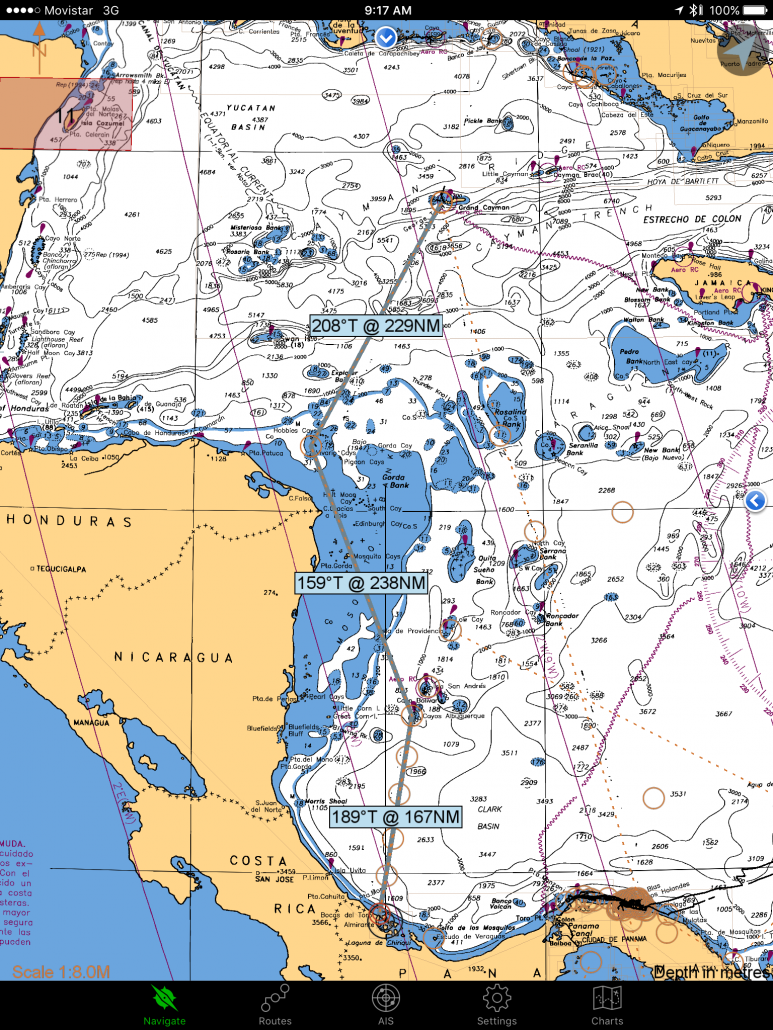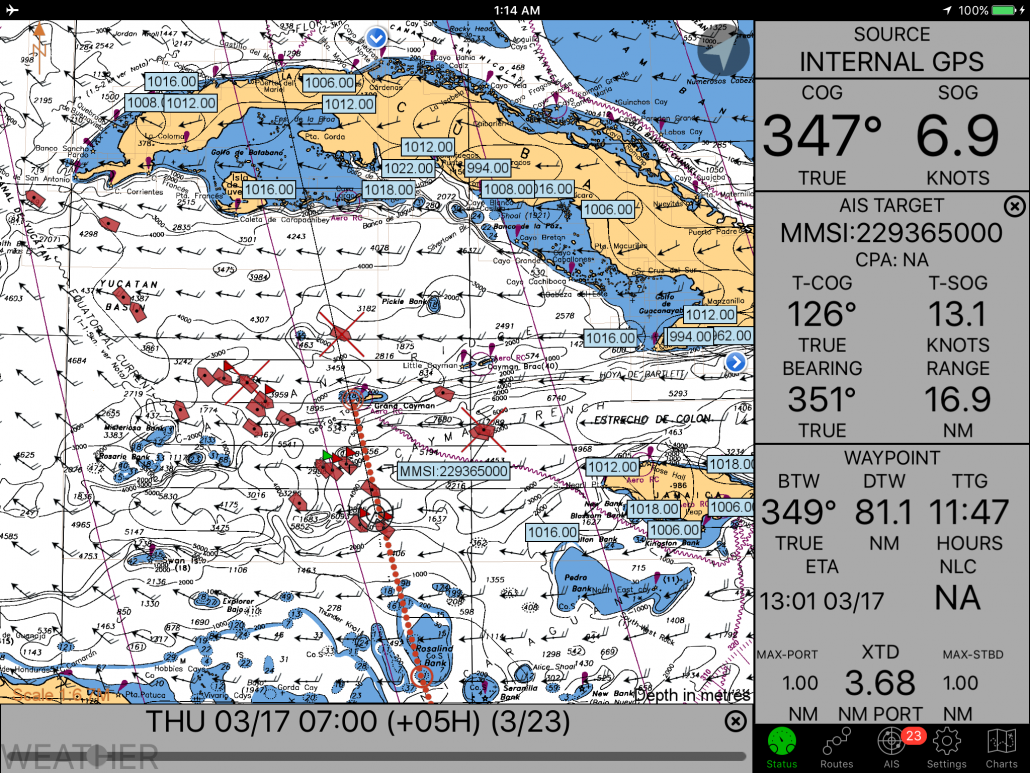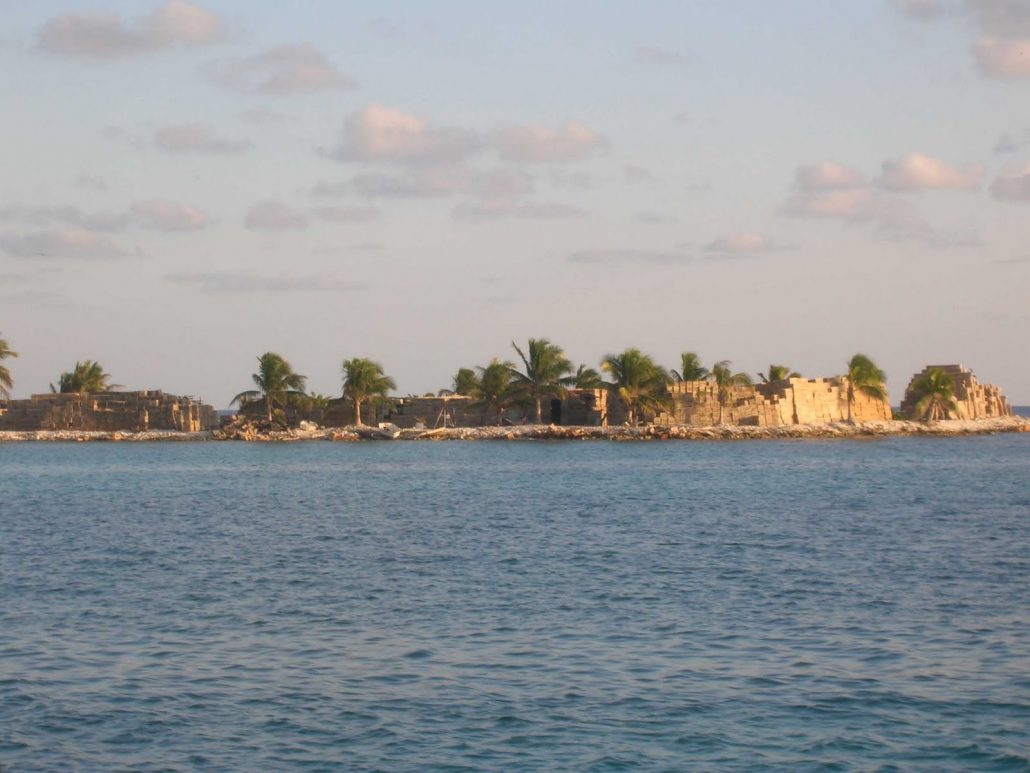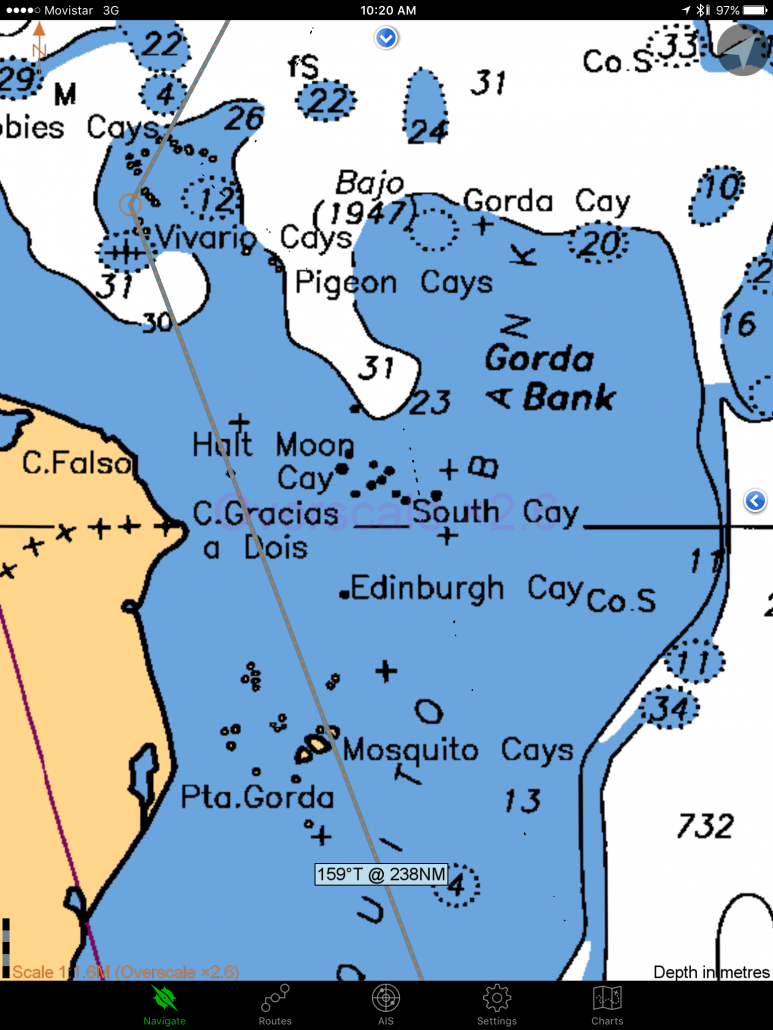Yeah. It’s been awhile. Apologies. Because of the time between posts, I’ve come up with a great number of semi-valid excuses for the delay. I could probably make an entire post out of excuses. But let’s not and say we did.
So what’s happened? Everything. Now? I’m in Bocas, playing with waves and surfboards. Here are the CliffsNotes.
Last check-in was in the incredibly expensive but well-stocked Cayman Islands. There I dropped off one crew member that wasn’t working out and Ana and I took off toward Panama – of course we took the long-way-round. The route was to Bocas Del Toro via The Hobbies (Honduras) and then Providencia/San Andres (Colombian islands off the coast of Nicaragua) and then to Bocas. The jumps were roughly 200 miles each. No sweat. Honestly, those jumps don’t even get my blood going anymore. But complacency is dangerous, and I’m avoiding that.
Here’s what the route looks like on the charts (it’s been oversimplified, grossly – routes are never this straight):
Leaving the Caymans was tricky. We needed a specific weather pattern, apparently an abnormal one for this time of year. We got it one day, but we were hungover from a little sailor get-together that was supposed to be “just one drink.” There is very little worse than starting a passage with little sleep and a hangover. We waited.
Then we were gifted the right weather.
And then we left.
To The Hobbies
What can I say about this passage? It was a rough one. For a relatively short passage – it kicked my ass. But it wasn’t nearly as bad as the next one. Before we get too far down this road – here’s a screenshot that illustrates why AIS is a good investment.
Onward.
We pulled out anchor around 2000 hours. We motored for a couple of hours. Then we caught the wind and we were off. That night we were surrounded by squalls. We had to keep a reef in the mainsail the entire time – which dramatically decreased our power when we didn’t have a squall pounding us. We were averaging a little under 6 knots, which is a horrible average for NOMAD. But low speed and rough weather and lightning and big waves and crazy wind aren’t the issue.
The issue is that because of all of those things, when we’re getting smashed by squalls, I can’t sleep. There’s only one person who sits in the captain’s chair when all hell breaks loose. It’s a fact of life, and not one that I mind – assuming that it’s not day-in-day-out. Of course, this was day-in-day-out.
There was a silver lining. I was looking for it. When you’re soaking wet and exhausted and on edge and hungry and cold you look for those silver linings. The silver lining was that the waves hadn’t had enough time to grow to any incredible size. They were staying between the two and three meter mark, with the occasional 3.5 M (11 ft) sneaker. That’s doable. They were a little steep, and on the passage I wasn’t happy about how steep they were – but I would learn on our next movement what “steep” really meant.
When the sun finally rose I was too tired to even let the fishing lines out. I just heated up coffee and tried to read a little. This was, to date, the most intense situation in which I had re-read Huckleberry Finn. I did, however, relate very keenly to Jim and Huck’s struggles on the river with weather and darkness and other boats.
Ana came up and we ate and she took a shift at the wheel. I laid down in the cockpit and tried to catch a nap.
And then it was getting dark again and I could see squalls building on the horizon. I flipped on the radar and quickly saw it was going to be another one of those rough nights. It was. Shocking.
This evening the pattern became pretty predictable: we would be sailing in 10-15 knots of wind, surrounded by squalls and crumbling waves. Then the wind would die, the sails would flap. Then I would get ready for some shit – usually just reef the headsail. Then I would be in the shit. Like a switch was flipped, the wind would increase to 30-35 knots from the direction of the squall. I would run NOMAD in front of it until I got an idea of windspeed and then (assuming all was well) correct course, put on some clear glasses, and ride out the storm.
This. Over and over and over. It was very similar to my combat experience: long periods of boredom punctuated by moments of sheer terror. Then the adrenaline fades and exhaustion kicks in until your next shot of adrenaline.
Then it was morning. Finally. And I could see The Hobbies. I could also see hella storms all around us. Our stop in The Hobbies was supposed to be a relaxing time to regroup, do some epic diving, fill up on fish, etc. But as we approached (with no real charts) it looked incredibly uninviting. I knew by speaking with other sailors (and thanks to ActiveCaptain) the general area of the opening in the reef, but that was all. I didn’t know where the wrecks were and I didn’t know where the coral heads were. Not something you want to navigate when a storm is nipping at your heels and you don’t have light to see the reefs. But that is what we did. And we made it to anchor.
We spent nearly three days in The Hobbies, which was the end of our weather information. We did a bit of diving and took a couple of fish for the freezer. Here I saw a Black Grouper that was big enough to scare me – certainly the largest I’ve ever seen. And I managed to put a spear in him, but he managed to remove that spear after pretzeling it. We also saw a massive Leatherback Turtle. Other than that, the time there wasn’t super-remarkable. If we had better weather info we certainly would have stayed longer and seen more. It was beautiful. It was remote. And it was cool. I lost the pictures taken here… Major bummer. Here’s a picture from S/V Gypsea Heart that shows what the main island looks like: It’s just lobster/fish traps.
And here was where I get to use my first long-time-since-I-posted excuse (barring the we-were-sailing-in-remote-areas excuse). I left a hatch open during a sunny day in The Hobbies when we went diving. Beneath this hatch was my computer. Within an hour a storm blew in and soaked said computer. As you probably realize, there are no Mac Stores in The Hobbies. As a matter of fact, there are no stores. There are no people. There are no houses. There is absolutely nothing. Except birds and a bunch of fish traps. Normally, this is the kind of place I like – but without a computer? Not as cool.
To San Andres
Again, we were off. We pulled anchor early (1700 hours) because I simply didn’t trust the area (remember I had no charts and came in with no light). Naturally the wind was blowing 25 knots in our face as we left. But once we got out that wind was on our quarter and it was damn near perfect sailing. The waves were plenty large but we were moving nicely.
Then the wind dropped. At this point, I knew what that meant (admittedly, I also saw the squall on radar). And so the familiar routine began again. The first night wasn’t so bad. I was well-rested and well-fed and knew what was coming. I can also say that I’d had a bit of experience with the all-night squall-after-squall scenario. So, we bumped and bounced and bashed and lurched toward San Andres.
The next day I rested a little and then later in the day we ended up turning on an engine as the wind gave out.
That night was the roughest sailing I’ve ever done. That night was a real test. They say calm seas do not good sailors make. I hope there’s something to this. Otherwise it was just the ocean testing the limits of my sanity. After doing this for a couple of years, you get a feeling for most of the stuff. Engines breaking when the wind is beating you in the face and the reef is behind you – check. Autopilot failing while you’re singlehanding and trying to replace a fan-belt in the engine room – check. The boom falling off while sailing – check. The dinghy falling off in the middle of a crossing while you’re getting pounded by waves – check. The list goes on.
But nothing (except similar experience) prepares you for taking a sound thrashing by the ocean. You just have to live through it.
What made this night so shitty was something I recognized while planning our route, but didn’t quite understand the scope of. Our route from The Hobbies to San Andres took us over a long, shallow shelf (much of it less than 15M/45ft). Because of the strength of the weather previously – the waves had built and built and built in the deeper water. And then when they came across this bank, they stood up straight and started crumbling. What were 3M/9ft-4M/13ft, long-period waves in the deeper water were now larger, short period waves with faces resembling walls and tops that were breaking.
Here’s the bank, obviously the route is oversimplified again. I didn’t go crashing through the islands.
The squalls had picked up in intensity, so much so that I was having to sail with the main double-reefed. That kept our speed down to about 5 knots outside of the squalls(when we weren’t skiing down the face of waves while being pushed by 45 knots of wind). The night was black. Very, very black. Fairly regularly, though, lighting struck near us and illuminated our situation for a moment. Just long enough to raise your heartbeat. When the lighting struck it became apparent how tiny our little boat was and how big the ocean around us was and how little control we really had over the situation.
It was, literally, walls of water breaking all around us (and on us). There was nowhere to run. When we were in the trough of the waves the next wave would be much higher that the arch my solar panels are on – way over my head. And then they would crumble onto us. I was wearing foul-weather gear, but at some point it doesn’t really matter. After a few waves break over you – you’re soaking wet and just holding on and hoping for the best.
At the height of it all I said some words to the ocean, something that would have passed for a prayer when I was a religious person. I remember that moment clearly now. We had two reefs in the main, two reefs in the headsail, and the radar was orange and yellow all around us. The rain was stinging. I was wearing glasses to see through the water. I was soaked to my bones and the lighting struck in regular intervals around us. I noticed we couldn’t hear most of the thunder because of the sound of the waves smashing into us. It was a hell of a deal. The sound alone is incredible. You can’t hear anything but the wind and the waves booming as they break on/over the boat. It’s completely black and you’re pitching, then lightning strikes and you see white water on top of black walls everywhere – and then it’s all gone again in a second.
The wind went from about 8 knots to about 45 knots.
I was OK up to about 40 knots with both sails double reefed. But 45 knots scared me a little and so I ran NOMAD front of it. Even running in front of it, as we were surfing down the waves we were consistently doing over 11 knots. The waves were breaking over us when we were in the troughs and all I could do was to hope.
We made it through it, mostly unscathed. The boat can always take more than it’s inhabitants
Eventually my adrenaline washed away and I was exhausted. I realized the next morning that my jaw was sore: I’d been clenching my teeth all night. As we came into the deeper water everything smoothed out (but it was still very rough) and I could hear San Andres Port Authority telling everyone the conditions were “Red” and that all small boats should seek shelter. That was very much our plan. Much to my surprise there were fishermen (in tiny pangas) out in that mess with us. I was impressed. Some of these local guys are excellent watermen. Some. Others are just insane.
We eventually pulled into San Andres, where we saw Mike and Laura on Gilana. It was nice to see a familiar boat and some familiar faces.
I know, I know...



